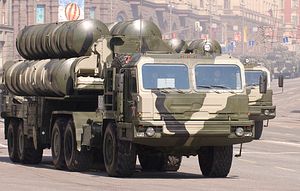Russia and India will soon conclude the final contract for the delivery of five regiments of Russian-made S-400 Triumf advanced Air Defense Systems (NATO reporting name: SA-21 Growler), according to a senior Russian defense industry official.
The head of Russian arms exporter Rosoboronexport, Alexander Mikheyev, told TASS news agency on the sidelines of the Le Bourget international aerospace show on June 21 that the signing of a final contract is imminent. “Rosoboronexport is carrying out pre-contractual work with Indian partners. We are discussing the technical issues of the deliveries. I can assure you that both our company and the Indian side are set to sign the contract soon,” the chief executive officer said.
As I reported previously (See: “India and Russia Ink S-400 Missile Air Defense System Deal”), Indian Prime Minister Narendra Modi and Russian President Vladimir Putin signed an intergovernmental agreement for the procurement of five regiments of S-400s in October 2016 during the eighth BRICS summit. India will be the second country after China, which ordered six S-400 battalions in 2014, to receive one of Russia’s most advanced air defense systems. China is expected to receive the first S-400 units in 2018.
“The S-400 Triumf long-range air defense missile systems will be delivered to China in strict compliance with the contract concluded between Rosoboronexport and the Chinese side. There are no causes to doubt the timely and qualitative fulfillment of the accords,” Mikheyev said this Wednesday.
The S-400 is capable of engaging missiles of all types and ranges, stand-off jammer aircraft, as well Airborne Warning and Control System (AWACS) aircraft. It can also engage targets in an electronic countermeasures environment. The new weapons systems will significantly boost India’s and China’s anti-access/area denial (A2/AD) capabilities. As I explained elsewhere:
In comparison to its predecessor, the S-300, the S-400 air defense system features an improved radar system and updated software; it can purportedly can fire four new types of surface-to-air (SAM) missiles in addition to the S-300’s 48N6E, a vertical tube launched, solid fuel, single stage SAM with an estimated range of 150 kilometers (93 miles), and the improved 48N6E2 missile with a reported range of 195 kilometers (121 miles).
One of the S-400’s new missiles is the so-called 40N6 SAM with an estimated operational range of 400 kilometers (248.5 miles) and an altitude of up to 185 kilometers (607,000 feet). The missile is reportedly capable of exo-atmospheric interception of intermediate-range ballistic missile warheads in their terminal phase. However, it is unclear whether the weapon is operational in Russia yet and no images of the 40N6 SAM have surfaced so far.
The S-400 is also armed with an improved variant of the 48N6E2 with an alleged range of 250 kilometers (160 miles). The air defense system can also fire two additional missiles, the 9M96E and 9M96E2 with respective ranges of 40 km (25 miles) and 120 km (75 miles). Improved S-300 air defense systems such as the S-300PMU-2 Favorite (sold to Iran), can purportedly also fire the 9M96E and 9M96E2. The S-400 can purportedly fire missiles at a rate 2.5 times faster than its predecessor, the S-300.
The India military is expected to deploy three S-400 regiments in the country’s west, facing Pakistan, and two regiments in the east near the Sino-Indian border. One S-400 is divided up into two battalions. Each battalion consists of eight launchers armed with up to 32 missiles.
































